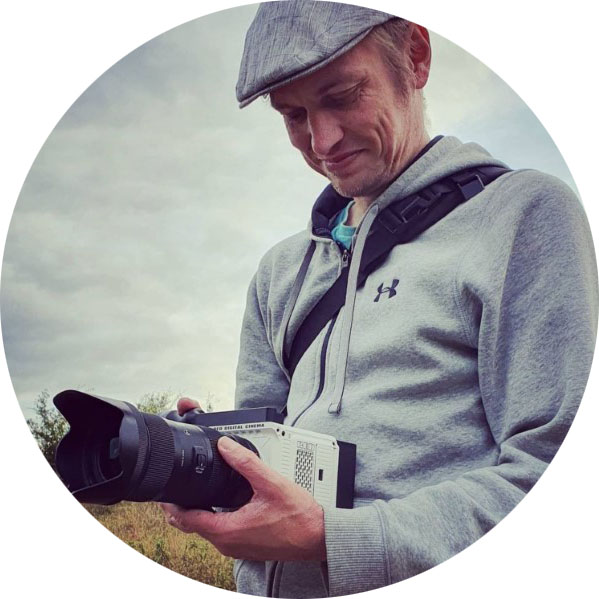DISCLOSURE: AS AN AMAZON ASSOCIATE I EARN FROM QUALIFYING PURCHASES. READ THE FULL DISCLOSURE FOR MORE INFO. ALL AFFILIATE LINKS ARE MARKED #ad
A nice backdrop helps set the tone, add context to your story, and make your videos look more professional. Here are six vlog background ideas for your YouTube videos.
1. Solid Backdrops
A solid backdrop is one of the most common background options that can help increase your videos’ production value and professionalism. This category includes sheets, curtains, other fabrics, and paper screens.
Solid backdrops generally provide a consistent, clean appearance to videos and keep the focus on the presenter. Because of this, they are typically used in instructional videos, news, and product reviews.
The type of paper backdrop rolls Potato Jet uses are expensive and found in many professional photo and videography studios. They require a wall (or ceiling) mount and seamless paper rolls.
However, there are a lot of cheaper background options available on Amazon.
2. The Collage Background
A collage is a simple background solution for YouTubers who don’t have a lot of space for filming.
They’re versatile, too, as collages serve the dual purpose of adding wall art to a space—such as a bedroom or home office—and providing a consistent backdrop across videos.
They can also help you convey your personality through subtle details in the background, which is why they’re popular in the vlogging community.
3. Create a Set
One background that can make your videos stand out in search results is a custom backdrop or set.
Essentially a craft project, these are backdrops that can be made once and reused to give your channel a consistent look, or they can be tailored to the subject matter of each specific video.
For example, if you’re shooting a birthday or New Year’s vlog, create a party set featuring a solid background of streamers, balloons, and other decorations. If your channel focuses on nature, create a fake grass wall for your backdrop, like the one in this video.
The endless options allow you to flaunt your crafting skills and creativity. Alternatively, you can hire someone to do it for you.
4. Use Your Room as a YouTube background
A great natural backdrop option is to film your video with the rest of the room in the background.
Showing viewers the space where you shoot is an ideal way to convey your personality, invite your viewers into your professional space, and give your videos a cozy, casual feel.
If you always film in the same room, it’s also practical and unobtrusive—allowing you to leave their gear set up and avoid the hassle of future equipment preparation.
Whatever room you choose, make sure to keep it clean and visually interesting, using colored LED tubes or other types of lights. After all, audiences don’t want to see your unmade bed or dirty laundry in the background.
If your room isn’t that interesting, you can shoot on a lens with a fast aperture to create a shallow depth of field. This will add a soft bokeh (blurry background) effect to your footage, making it look more professional and appealing.
Variations and Ideas:
Show off different rooms of your house depending on the subject of your video.
Film in front of your closet if you’re talking about your new wardrobe.
If you’re making a food video, let viewers see your kitchen or dining room. If you usually shoot videos for your food blog in the kitchen, try doing it outside in the summer, in the garden where you harvest your crops, or in the local market where you get groceries.
5. Use Photos or Animations as backdrop for your YouTube videos
You can use photos or animations to create a backdrop if you film against a green screen.
This technique requires some knowledge of green screens and keying and additional post-production work.
You can also use AI to make your room look more interesting with AI-generated photos or animations. This requires a bit of post-production.
Do some research and see what’s available, as there are plenty of pre-made animations (especially backgrounds) that you can find on websites like Shutterstock and MotionArray.
6. Shoot video on location
Depending on what type of videos you create, another perfectly viable option is to have an ever-changing background—that is to say, you can shoot on location.
If your projects are scripted or typically involve interacting with the public, simply filming in your home office in front of a solid backdrop won’t suit your needs. This is a given if, say, you’re a travel vlogger.
Sometimes, shooting on location can be challenging, especially if there are many pedestrians or loud noises nearby or if other external factors arise that are outside of your control.
Bring a friend to watch your camera and gear while you talk, or shoot handheld with a phone or small gimbal-camera combo like the DJI Osmo Pocket 3.
Also, use a Lavalier microphone close to your body to minimize excess noise.
Final Thoughts: Decide if you want a natural or ‘artificial’ background for your YouTube video
You must decide whether to use a natural background (like your room, kitchen, or a location) or a set-style/artificial background (like a colored backdrop, a green screen, or an AI-generated one).
Choosing between “natural” or “unnatural” backgrounds is largely stylistic, but it should be based on the video content you plan to produce.
In any case, lighting is important. It should make you look good, and colored LEDs and a cool lamp can do wonders in a boring room. Again, consider your subject. If you’re talking tech gear, you might want some colored lights, but if you’re making videos for your food blog, it’s better to go for a high-key look.
Up Next: What Is High Key Lighting, And How Do You Create It?

